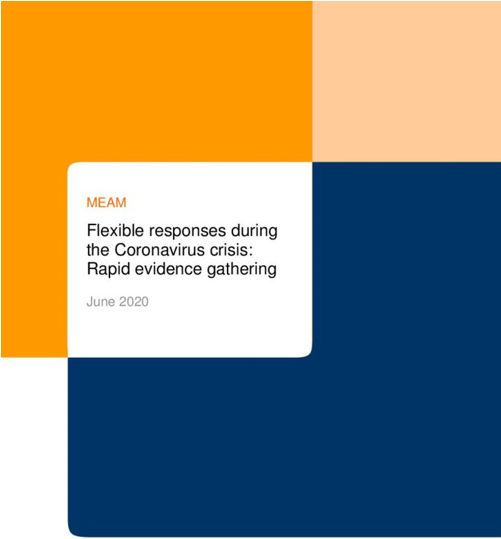Today, the MEAM coalition has published new research examining the flexibilities that homelessness, substance misuse, mental health and criminal justice services have put in place to support people during the Covid-19 crisis, and how some of the positive aspects of these changes might be maintained in the future.
The research is launched on the day that the Ministry of Housing, Communities and Local Government requires all local authorities to submit outline transition plans for the next stage of the homelessness Covid-19 response.
MEAM wants local areas and the national homelessness taskforce to ensure that these plans take account not just of housing, but the full spectrum of support that people need to live fulfilling lives.
You can also read a presentation summarising the findings here.
SUMMARY OF FINDINGS
The Rapid Evidence research, undertaken by Cordis Bright over a two week period, found that:
- There were flexibilities across a range of sectors, including:
- Substance misuse treatment: Individuals assessed and offered support more rapidly; increased regular virtual support contact; reduction in supervised consumption of medication and prescriptions covering longer periods of time.
- Homelessness support and housing services: Emergency accommodation to support the ‘everyone in’ policy; in-reach support for individuals residing in this accommodation provided by a wide range of partners on multiple issues; increased flexibility by housing associations and other housing providers in relation to who they accepted in their properties.
- Criminal justice: Improved safe accommodation for people released from prison in some areas; increased partnership working between police and other agencies; continued face-to-face contact with probation. It was noted that conditions in prisons have worsened during the pandemic, with prisons implementing internal lockdown measures and not allowing visits.
- Mental health: Relatively limited adaptations compared to other service areas, however; greater provision of mental health assessments and psychological support in some areas; improved discharge planning for people receiving in-patient care; some specialist mental health services.
- Women specific support: Domestic abuse services in several areas received additional resources to expand their work, but there was also a recognition of the lack of suitable accommodation for women facing multiple disadvantage.
- There were positive and negative impacts on services and systems
The report looked at why and how these changes occurred and the impact on local systems. It found that:
- Shared purpose: There was a clear shared purpose to prevent individuals contracting the virus. This drove reforms quickly and provided direction for people making decisions together across agencies.
- Risk: There was a change in the balance of risk, with the risk of making bold decisions and trying new ways of working being less than the risk of leaving people without support. This drove innovation in service delivery.
- Staff autonomy: Greater autonomy was given to front line staff to adapt how they worked. Managers allowed staff to quickly work with individuals and agree with them what support would be most suitable for their needs and circumstances.
- Local accountability: Local accountability to protect the most vulnerable increased, with agencies and services reporting that they could no longer ‘not be sat around the table’ to work with this group.
- Impact on people
The research found that the changes had a mix of positive and negative impacts on people, including:
- Adapting well: Many clients had adapted well to their new circumstances, were engaging with more services and had displayed considerable resilience.
- Trust: There was increased trust between clients and support workers.
- ‘Knock-back’: Some clients experienced ‘knock-back’ to progress due to lockdown restrictions.
- Remote support: Remote support was welcomed by some and less effective for others.
- Planning for the transition
The research asked local areas what they were doing to plan for the transition. It found that:
- Learning and reflection: Most respondents were confident that their areas were taking the opportunity to learn and reflect (but couldn’t always point to where this was happening).
- Leadership: Leadership on ‘transition planning’ was coming mainly from housing, with less evidence of wider ‘cross-sector’ planning.
- Involvement of lived experience: There was little evidence of involvement of people with lived experience.
- Challenges: People were worried about funding, timescales and a “return to the status quo”.
- Next steps
The research concluded that as we transition out of the crisis, local areas and national government are likely to need to consider the following in order to maintain some of the positive changes that have been developed during the pandemic:
- Reflecting closely on learnings from the crisis period: Local areas and national government may wish to consider which new flexibilities have been effective at improving outcomes for people facing multiple disadvantage as well as which changes have been less effective and why. A clear process will be needed for reflection and learning.
- Cross-sector leadership and planning to ensure positive changes can be maintained: Local areas and national government should build on the reflection and learning above, identifying the flexibilities that they wish to maintain and developing plans to ensure that this can be funded and commissioned. The provision of suitable, permanent accommodation for all who need it will be a key part of this, but wider cross-sector flexibilities will also be important.
- Ensuring the involvement of people with lived experience of multiple disadvantage: Local areas and national government should ensure that people experiencing multiple disadvantage are at the centre of conversations regarding the next stage of the response.

